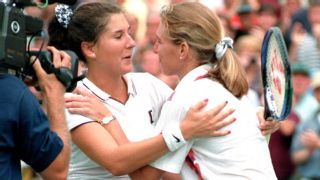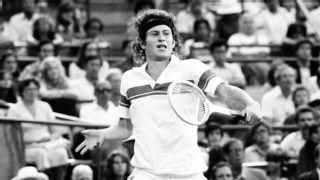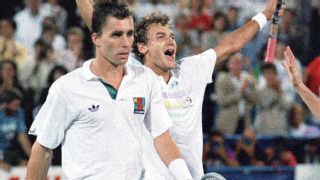|
NEW YORK -- Echoes. Long after the USTA demolishes Louis Armstrong Stadium, work that will begin immediately after the conclusion of this US Open, the echoes will remain. They will resound even after a state-of-the-art roofed stadium is built and inaugurated on the venerable Armstrong footprint in 2018. Younger tennis fans might not even know that Armstrong, originally built for the 1964 World's Fair and called the Singer Bowl after the sewing machine manufacturer, was the main stadium of the US Open until 1996. When Arthur Ashe Stadium was completed and put to service in 1997, Armstrong became the subordinate. It continued to produce thrilling matches, many of which lasted well into the morning hours. The very first match on Armstrong was between Bjorn Borg and Bob Hewitt. The final one was a quarterfinal men's doubles clash Tuesday between the Hall of Fame American team of Bob and Mike Bryan and Feliciano Lopez and Marc Lopez (they aren't related) to close out an era. Everyone probably has a list of favorite Armstrong matches. Here is our top 10 countdown: No. 10: 1993 second round, Mats Wilander d. Mikael Pernfors 7-6 (3), 3-6, 1-6, 7-6 (6), 6-4This match didn't even start until 10:26 p.m. Pernfors, a Swede who had played collegiate tennis at the University of Georgia and won the hearts of many fans with his appealing clay-court game, was in the midst of a comeback. Wilander, a fellow Swede who had lost his drive after becoming No. 1 in 1988, was also trying to reinvent himself. Mounting a furious comeback, Wilander finally won the match before a sparse but enthralled and enthusiastic clutch of fans at 2:26 a.m. No. 9: 1995 final, Steffi Graf d. Monica Seles 7-6 (6), 0-6, 6-3 This match was tantalizing because it featured one of the most remarkable, and bizarre, backstories in tennis history. Seles had been successfully challenging Graf's supremacy until a deranged Graf fan stabbed Seles during a match two years earlier. The US Open was just Seles' second tournament, and first Grand Slam, back on tour. When Seles blanked Graf in the second set and it appeared that she might be picking up right where she left off, Graf roared back to win her 18th career Grand Slam singles title. No. 8: 1984 semifinals, Ivan Lendl d. Pat Cash 3-6, 6-3, 6-4, 6-7 (5), 7-6 (4)This match was one of four epic battles on what still might be the greatest and certainly most competitive day in Open tennis history. This "Super Saturday" began at 11:07 a.m. with Stan Smith defeating John Newcombe in the senior men's semifinals 4-6, 7-5, 6-2. Later, Martina Navratilova captured her second straight US Open singles title, defeating Chris Evert 4-6, 6-4, 6-4. John McEnroe and Jimmy Connors ended the day's play at 11:14 p.m. with McEnroe eliminating the two-time defending champion in a five-set barnburner. But the first semifinal featuring Lendl and Cash was the most thrilling match of them all, with Lendl surviving a match point to win it. Lendl played eight US Open finals in a row starting in 1982, winning three. No. 7: 1980 final, John McEnroe d. Bjorn Borg 7-6 (4), 6-1, 6-7 (5), 5-7, 6-4 This was McEnroe's second straight US Open title, but the path to it was agonizing. He dismantled rival Ivan Lendl in four sets in a quarterfinal, eliminated Jimmy Connors in one of their epic five-setters in the semifinals, and finally whipped Borg in final. McEnroe avenged his loss to Borg in the Wimbledon final of a few months earlier. Borg would not be the same player again after this final. No. 6 1981 final, Tracy Austin d. Martina Navratilova 1-6, 7-6 (4), 7-6 (1)This was the 100th anniversary of the U.S. Championship. Fittingly, Americans would claim both singles titles as well as the men's and women's doubles titles. One day before McEnroe defeated Borg in the men's final for the second year running and drove Borg from the game, 18-year old Austin also toppled an icon. The blonde youngster from Rolling Hills, California, had barged right into the developing rivalry between Chris Evert and Navratilova, rattling both veterans. Navratilova was just coming to the peak of her powers at the time of this match and playing in her first US Open final. She attacked relentlessly, but Austin's accuracy, consistency and nerve were too much. Navratilova, who had upset Evert in the semifinals, double-faulted on match point. No. 5: 1999 third round, Serena Williams d. Kim Clijsters 4-6, 6-2, 7-5This was the year 17-year-old Williams went on to win her first US Open title, and she remembers this three-setter on Armstrong well. "No one knew who Kim Clijsters was at the time," Williams said. "She became such a wonderful, great player. I was just on the come-up myself. That propelled me to win my first Open. That's something I'll never forget." No. 4: 1992 semifinals, Stefan Edberg d. Michael Chang 6-7 (3), 7-5, 7-6 (3), 5-7, 6-4 This match was the centerpiece of one of the greatest "ironman" runs in Open tennis history. Edberg had rebounded from fifth-set deficits against Richard Krajicek in the round of 16 and Ivan Lendl in the quarterfinals. In the semifinals he faced the same hopeless situation against one of the toughest, most consistent players on tour. Chang had a reputation as indefatigable, but Edberg found stamina even he didn't know he possessed to outlast Chang in the longest match in US Open history, five hours and 26 minutes. Edberg went on to defeat 1990 US Open champ Pete Sampras in the final. No. 3: 1996 quarterfinals, Pete Sampras d. Alex Corretja 7-6 (5), 5-7, 5-7, 6-4, 7-6 (7)This was the last year Armstrong was the main stadium at the US Open. Sampras was an established talent by this point, and Corretja a young Spanish clay-court artisan. Some critics still felt that it all came too easily for Sampras, that he was not prepared to dig deep and leave it all out on the court in order to win. But in this match, Sampras demonstrated that his heart was as big as his serve. He overcame a spirited opponent, dehydration and cramps. At one point he retreated to the back of the court and vomited. Woozy and struggling to focus, he still managed to win in a fifth-set tiebreaker. "It showed the tennis world that I have heart," Sampras later said of that remarkable performance. No. 2: 1991 fourth round, Jimmy Connors d. Aaron Krickstein 3-6, 7-6 (8), 1-6, 6-3, 7-6 (4)This match might not have had the superb shot-making or big-picture resonance of some on this list, but who hasn't seen it repeated during a US Open rain delay (in the pre-roof era) or cited in any number of documentaries? Connors was 39 years old, and it was his birthday. He roared back from a 5-2 deficit in the fifth set as the crowd sang "Happy Birthday." This match was the apex of Connors' remarkable run at that US Open. Its resolution was as improbable as a feel-good sports movie, even if it left Krickstein feeling lousy, like he had been reduced to a prop in the narrative created by a man whom he considered a friend and mentor. No. 1: 1988 final, Mats Wilander d. Ivan Lendl 6-4, 4-6, 6-3, 5-7, 6-4 This match was played on a Monday, which unfairly diminished its impact. It's the least acknowledged of all the "greatest" tennis matches. But it is right up there on the short list of the most compelling tennis matches of this or any other era. At four hours and 55 minutes, it's still the longest singles final in US Open history. Lendl was well-nigh invincible at the US Open by then, having won the three previous finals. But Wilander was in the midst of his career year. A win in the final would earn him the No. 1 ranking for the first time in his career and make him one of the few men in tennis history to win three majors in the same year (Wilander never did win Wimbledon). The match was a brilliant struggle in which each player freely changed tactics each time his opponent seemed to gain some comfort. Games were fought over as bitterly as sets. Unforced errors were scarce. That Wilander seemed a David against Lendl's Goliath only enhanced the occasion. Winning the match took so much out of Wilander that he soon went into a motivation and rankings swoon from which he never really recovered.
|
